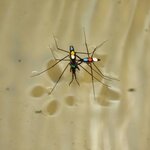Ecology & Zoology

Biologists say they have found a population of tropical butterflies that may be on its way to a split into two distinct species. The cause of this particular break-up? A shift in wing color and mate preference.
In a paper published this week in the journal Science, the researchers describe the relationship between diverging color patterns in Heliconius butterflies and the long-term divergence of populations into new and distinct species.
"Our paper provides a unique glimpse into the earliest stage of ecological speciation, where natural selection to fit the environment causes the same trait…

Female water striders don't like the bad boys and they don't even have to reach the age of 30 before they wise up about choices in males.
Water striders are those insects commonly seen skittering hurriedly across the surface of streams but when it comes to romance, male water striders who played it cool mated with more females than did groups of aggressive males, according to a study led by Omar Tonsi Eldakar of the University of Arizona's Arizona Research Laboratories.
Previous studies have found that more sexually aggressive males are the most successful at reproducing, said Eldakar, now a…

But you wouldn't know that from reading this article in the Winnipeg Free Press. It's like the definition of irresponsible journalism: repeating rumor as fact, failing to interview experts, and just flat-out making things up.
For example, did you know that "dime-sized suction cups on the tentacles of squid are lined with sharp teeth that leave permanent scars if they contact human skin?" No, you didn't, because it's not true. I've been scratched by these "teeth" countless times, and nope, no scars.
I've already explained why squid probably don't eat humans, so I'll just do a quick play-by-…
You're toxic, I'm slipping under . . .
The music video for Britney Spears' hit Toxic would have been so much better with truly toxic creatures in starring roles. Can you imagine the pop star serving drinks to newts, dancing with a pufferfish, and finally, of course, succumbing to the deadly embrace of a blue-ringed octopus?
When I wrote about the toxicity of flamboyant cuttlefish a few entries back, a thoughtful commenter linked to a journal article about cephalopod toxins, and a popular news story covering the findings. The study is interesting, to be sure, but I disagreed rather strongly…

Charles Darwin described a canid on the Falkland Islands, off the east coast of Argentina, but it has long been extinct. Darwin called it Canis antarcticus, placing it in the same genus as the domestic dog, wolf and coyote
Since then, biologists have also puzzled over the Falklands wolf's ancestry, with suggestions that they were related to domestic dogs, North American coyotes, or South American foxes. The wolves were the size of a coyote, but much stockier, with fur the color of a red fox. They had short muzzles, just like gray wolves, and thick, wooly fur.
Researchers reporting…

Yay! "Squid Says: What's For Dinner?" made it into the finalists*. To celebrate, here is one of my all-time favorite cephalopod pix.
I know, I know, it's a not a squid! But isn't it the cutest? The picture is by James Wood, who was the first to ever witness mating and hatching in this species--a deep-sea octopus named Bathypolypus arcticus. This pleasantly informative Latin name translates to "Arctic deep-water octopus."
Polypus means "many feet" instead of the more precise "eight feet" of octopus; apparently some ancient Greeks couldn't be bothered to count. For many years both polypus (…

In honor of the impending holiday, the LA Times offers up a selection of thirteen "Nightmares from the animal kingdom".
No costumed ghouls, ghosts or goblins that may ring your doorbell this Oct. 31 can compare with the all-too-real, creepy-crawly, slimy and all-around bizarre critters conjured up byMother Nature. They're weird, they're wild and they're ready to invade your nightmares.
Number one on the list is poor Vampyroteuthis infernalis, whom I've discussed before. I tend to think of them as shy creatures who really wish they hadn't been given such a flashy name, but maybe they secretly…

You've never seen anything like these photos. No one has.
The captivating pictures show adult sperm whales feasting on a rare* giant squid.
The coolest part of this story is not that someone saw sperm whales eating a giant squid, but that these adults were teaching a calf how to eat giant squid. Training the next generation of ruthless squid predators.
How hard can it be to eat a giant squid, you may ask, especially with teeth like that? It's probably not that hard to eat it, but first you have to catch it. In the vast, dark depths of the ocean, where giant squid (understandably) prefer to…

The squid family Ommastrephidae includes my favorite Humboldt squid, along with a lot of other big-time commercial fishery species. How do they sustain the largest invertebrate fisheries in the world? Well, ommatrephids are large, muscular, and abundant, which means each squid you catch has a lot of meat, and there are a lot of squid to catch.
Humans are only the most recent predator to figure this out. Ommastrephid squid have been showing up prominently, and sometimes exclusively, in the diets of fish, sharks, dolphins, whales, and seabirds, as long as anyone's been looking.
Perhaps not…
After yesterday's cliffhanger, I suppose I should explain what it means for a squid to fly. Can they control their aerial trajectory? Can they gain altitude, once airborne, which is the definition of "true" flight?
Strangely enough, very little research has been done on squid flying. Or maybe this isn't so strange--it's not the easiest behavior to study, after all! In my time at sea I've seen hundreds, maybe thousands, of flying fish, but I've never seen a flying squid. And yet ommastrephid "flying squid" live all over the place: Todarodes pacificus in the Western Pacific, Dosidicus gigas in…